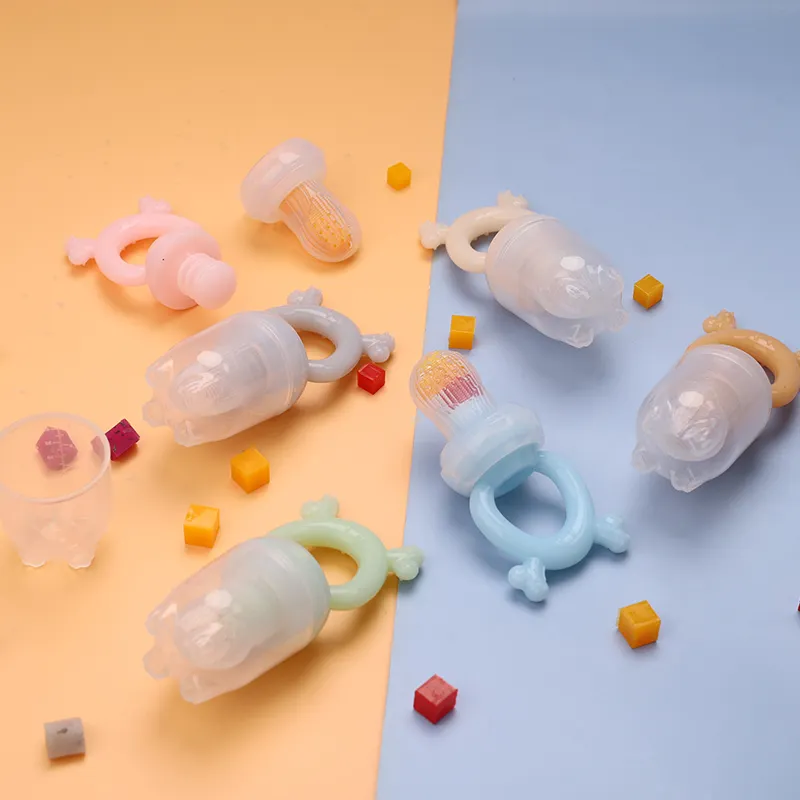What Is a Baby Fruit Feeder?
Definition and Basic Structure
A baby fruit feeder is a specialized tool designed to ensure infants can explore solid foods safely while reducing choking risks. It's typically composed of a silicone or mesh pouch nestled within a plastic frame, making it easy for tiny hands to grasp. This structure allows parents to fill the feeder with different fruits or soft vegetables, while the child gnaws on it to extract juice and pulp. The feeder's design is ergonomically suited to aid infants in holding and maneuvering the pouch effortlessly.
Purpose in Transitioning to Solids
The primary purpose of a baby fruit feeder is to assist infants in transitioning from liquid to solid foods, encouraging independent feeding in a safe manner. It plays a vital role in developing fine motor skills, as babies learn to grasp, shake, and manipulate the feeder. Additionally, it provides a sensory experience by introducing various textures and flavors, critical for nurturing healthy eating habits as the child grows. Engaging with different tastes and textures early on helps build a positive relationship with food, facilitating easier adaptation to diverse dietary choices later in life.
How Does a Baby Fruit Feeder Work?
Design Features for Safety
A baby fruit feeder is designed with several safety features to reassure parents about their baby's feeding experience. Firstly, a secure locking mechanism is crucial as it prevents accidental opening, ensuring the food remains inside the feeder. This feature reduces the risk of choking, which is a major concern when introducing solids to infants. Furthermore, the materials used, typically BPA-free silicone, are selected for their durability and safety against harmful chemicals. This ensures that the feeder can withstand the wear and tear of regular use without posing any health risks. The design also minimizes any sharp edges, making it safe for babies to chew on without risking injury, allowing parents to be confident as their child explores new textures and flavors.
Mechanism of Self-Feeding
The mechanism of a baby fruit feeder empowers infants with the ability to control their feeding journey, promoting independence at a young age. The design of the feeder allows babies to suck or gnaw on it, making them capable of accessing the food inside at their own pace. This promotes the crucial skill of self-feeding, enabling children to learn how to manage food independently, which is an essential step in their development process. By encouraging exploration, the feeder allows babies to experiment with different fruits and vegetables, fostering natural curiosity and helping them to discover a variety of tastes and textures. This not only nurtures their sensory skills but also aids in building healthy eating habits from an early stage.

Key Benefits of Using a Baby Fruit Feeder
Safe Introduction to Solid Foods
Using a baby fruit feeder significantly reduces the risk of choking compared to offering whole food pieces, allowing parents to confidently introduce solids to their little ones. As mentioned in studies, early exposure to a variety of flavors can help prevent picky eating habits later on. These feeders encourage a gradual introduction to solid foods, helping babies safely navigate through different textures and flavors. By allowing babies to taste different foods without the risk of choking, these feeders serve as an effective tool for a smooth transition from milk to solids during this important phase of development.
Teething Relief and Sensory Exploration
The baby fruit feeder also provides relief for teething babies, as the act of gnawing on the feeder can soothe sore gums, offering much-needed comfort. Additionally, it permits sensory exploration; babies can try new textures with reduced risk of choking, making feeding not only safe but also stimulating. This type of exploration aids in developing crucial oral motor skills, essential for speech and feeding success as the child's development progresses. Therefore, using a fruit feeder encourages oral and sensory skills, contributing to overall developmental growth in infants.
Silicone vs. Mesh Feeders: Types Compared
Material Safety and Durability
When choosing between silicone and mesh feeders, material safety and durability are key factors to consider. Silicone feeders are generally more durable and less prone to tearing compared to mesh options, offering longer-lasting use. This makes silicone a practical choice for parents who prioritize durability in baby products. Additionally, both materials are safe for babies, but silicone has an advantage in terms of cleanliness. It's easier to clean and resist staining, making it more hygienic over repeated use. Evaluating these aspects can significantly affect both the safety and practicality of the feeder, influencing its longevity and effectiveness.
Cleaning and Maintenance Differences
Cleaning and maintenance can also differ significantly between silicone and mesh feeders. Silicone feeders often disassemble easily, allowing for thorough cleaning, which is a definite advantage for busy parents seeking simplicity. In contrast, mesh feeders can stubbornly hold onto food particles, requiring more attention and effort in cleaning. Fortunately, some feeders in both categories are dishwasher-safe, providing an easy solution for maintaining hygiene standards. Therefore, understanding these cleaning differences can help families select the ideal feeder type that fits their lifestyle and meets their hygiene expectations.
Best Foods to Use in a Baby Fruit Feeder
Soft Fruits and Vegetables (Bananas, Berries)
Utilizing soft fruits and vegetables such as ripe bananas and berries is ideal when using a baby fruit feeder. These foods are easy to mash and make the nutrients accessible to babies, ensuring they receive necessary vitamins and minerals during this critical development period. Babies often love the natural sweetness of these fruits, which can help ensure their first experiences with solids are positive and enjoyable. The nutrients, particularly the vitamins and natural sugars found in these fruits, are vital for supporting infants' growth and development. As I guide my own little one through their dietary journey, ripe bananas and berries are staples in our feeding routine.
Frozen Options for Teething Relief
Frozen fruits like bananas and blueberries are excellent for providing teething relief through a baby fruit feeder. The cooling effect of these frozen fruits helps ease discomfort and soothes sore gums, making them an essential component of any parent's teething toolkit. Beyond the soothing sensations, these frozen treats allow babies to explore different flavors in a safe and controlled manner. The fruit feeder plays a vital role by encasing these foods, reducing choking risks, providing peace of mind for caregivers. While helping my baby manage teething discomfort, these frozen fruits have proven to be both a relief and a delightful exploration of flavors.
Safety Guidelines and Choking Prevention
Food Size and Texture Recommendations
Ensuring that food pieces are adequately sized for your baby's feeder is essential to prevent choking hazards and ensure safe feeding. Experts recommend offering soft textures like ripe bananas and berries. These foods eliminate the risks associated with hard solids, which can create unnecessary stress. By carefully selecting food size and texture, parents can confidently follow guidelines from pediatric experts, enhancing safety during feeding times.
Supervision and Hygiene Practices
Constant supervision is paramount when your baby is using a fruit feeder. Observing your baby ensures they are using the device safely and can prevent accidents. Moreover, maintaining hygiene is crucial, which involves regular cleaning and sterilizing of the feeder to prevent bacterial growth. Educating caregivers on proper usage and safety practices surrounding the feeder can greatly reduce the risk of accidents. This proactive approach can help create a safe, enjoyable feeding experience.
How to Introduce a Baby Fruit Feeder
Step-by-Step Feeding Tips
Introducing a baby fruit feeder requires patience and gradual acclimation to ensure the baby is comfortable with the new feeding method. Start by offering the feeder without any food, allowing the baby to explore and familiarize themselves with it. Once they show comfortability, fill the feeder with a soft fruit, like banana or avocado, and demonstrate the self-feeding process to encourage their engagement. As the baby becomes more accustomed to using the feeder, you can gradually introduce a variety of soft foods while closely observing for any signs of allergies or aversions. This careful, step-by-step approach ensures a safe and enjoyable experience for both the baby and the caregiver.
Combining with Baby-Led Weaning
Integrating a baby fruit feeder into baby-led weaning provides an excellent opportunity for babies to explore food textures while learning to feed themselves. This approach allows babies to handle a balance of soft and solid foods, promoting a more comprehensive sensory experience. By encouraging the use of feeders alongside solid food pieces, we can facilitate the transition to solid foods smoothly. It is crucial to consult with pediatricians to optimize the weaning process, ensuring it suits the baby's developmental readiness and nutritional needs. This balanced approach not only supports babies in developing motor skills but also introduces them to the diverse world of flavors and textures they will encounter as they grow.
FAQ
What age should my baby start using a fruit feeder?
Babies can typically start using a fruit feeder as early as 6 months old, when they begin solid foods and show the readiness for self-feeding skills.
Can I use a fruit feeder to introduce vegetables?
Yes, you can fill the feeder with soft, steamed vegetables like carrots or sweet potatoes to introduce a variety of tastes beyond fruits.
How often should I clean the baby fruit feeder?
It's best to clean the feeder after each use to maintain hygiene and ensure safety for your baby.
Is a silicone feeder better than a mesh feeder?
Silicone feeders tend to be more durable and easier to clean, but the choice depends on personal preference and how easy you find each type to clean.
Can I freeze breast milk in a fruit feeder for teething relief?
Yes, freezing breast milk in a fruit feeder is an excellent way to soothe a baby's gums and offer nutritional benefits simultaneously.

